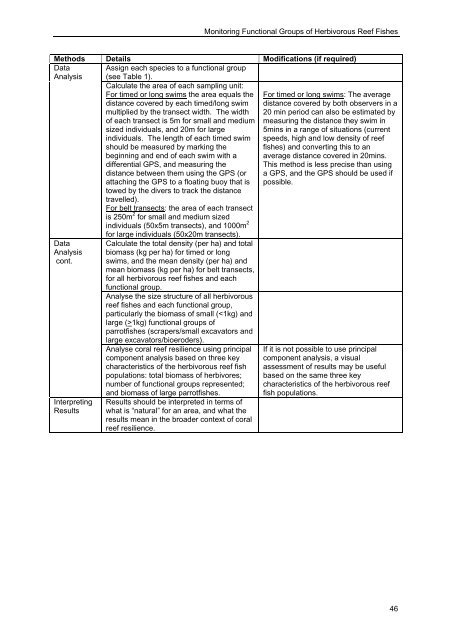Green2009-herbivore monitoring
Green2009-herbivore monitoring.pdf
Green2009-herbivore monitoring.pdf
You also want an ePaper? Increase the reach of your titles
YUMPU automatically turns print PDFs into web optimized ePapers that Google loves.
Monitoring Functional Groups of Herbivorous Reef Fishes<br />
Methods Details Modifications (if required)<br />
Data<br />
Analysis<br />
Assign each species to a functional group<br />
(see Table 1).<br />
Calculate the area of each sampling unit:<br />
For timed or long swims the area equals the<br />
distance covered by each timed/long swim<br />
multiplied by the transect width. The width<br />
of each transect is 5m for small and medium<br />
sized individuals, and 20m for large<br />
individuals. The length of each timed swim<br />
should be measured by marking the<br />
beginning and end of each swim with a<br />
differential GPS, and measuring the<br />
distance between them using the GPS (or<br />
attaching the GPS to a floating buoy that is<br />
towed by the divers to track the distance<br />
travelled).<br />
For belt transects: the area of each transect<br />
is 250m 2 for small and medium sized<br />
individuals (50x5m transects), and 1000m 2<br />
for large individuals (50x20m transects).<br />
Data<br />
Analysis<br />
cont.<br />
Interpreting<br />
Results<br />
Calculate the total density (per ha) and total<br />
biomass (kg per ha) for timed or long<br />
swims, and the mean density (per ha) and<br />
mean biomass (kg per ha) for belt transects,<br />
for all herbivorous reef fishes and each<br />
functional group.<br />
Analyse the size structure of all herbivorous<br />
reef fishes and each functional group,<br />
particularly the biomass of small (1kg) functional groups of<br />
parrotfishes (scrapers/small excavators and<br />
large excavators/bioeroders).<br />
Analyse coral reef resilience using principal<br />
component analysis based on three key<br />
characteristics of the herbivorous reef fish<br />
populations: total biomass of <strong>herbivore</strong>s;<br />
number of functional groups represented;<br />
and biomass of large parrotfishes.<br />
Results should be interpreted in terms of<br />
what is “natural” for an area, and what the<br />
results mean in the broader context of coral<br />
reef resilience.<br />
For timed or long swims: The average<br />
distance covered by both observers in a<br />
20 min period can also be estimated by<br />
measuring the distance they swim in<br />
5mins in a range of situations (current<br />
speeds, high and low density of reef<br />
fishes) and converting this to an<br />
average distance covered in 20mins.<br />
This method is less precise than using<br />
a GPS, and the GPS should be used if<br />
possible.<br />
If it is not possible to use principal<br />
component analysis, a visual<br />
assessment of results may be useful<br />
based on the same three key<br />
characteristics of the herbivorous reef<br />
fish populations.<br />
46


















